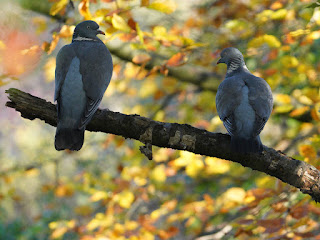A Great Spotted Woodpecker searched for insects in the bark of a plane tree near the Albert Memorial.
A Blackbird ate rowan fruit on Buck Hill. There's still no sign of migrant Mistle Thrushes or Redwings here.
A Great Tit, Blue Tit and Long-Tailed Tit hunted for insects in a nearby tree.
Another flock of Long-Tailed Tits (or perhaps the same one seen at a different time) worked down the south shore of the Serpentine ...
... and the east shore of the Long Water.
A Chiffchaff tagged along with the flock.
A pair of Wood Pigeons perched together in the autumn leaves.
There was a distant view from the Lido jetty of a Pied Wagtail hunting along the edge of the restaurant terrace ...
... so I hurried round to the terrace to get a better shot, to discover that it had been chased off by a Grey Wagtail.
The other Grey Wagtail was at the edge of the pool at the top of the Dell waterfall, looking a bit sad because the waterfall still hasn't been turned back on. Both birds were hatched at the Lido last summer.
The pool has been cleared of fallen leaves. The local Grey Heron still thinks there are fish in it, and is probably right.
Another of our regular Black-Headed Gulls has turned up: 2PSN, which was ringed in the unromantic surroundings of the Pitsea landfill site near Basildon.
EZ73323 was in its favourite place on the lifebelt pole.
A young Black-Headed Gull played with a twig.
Mute Swans passed by in the evening light.
An immature Shoveller drake paddled through sunny reflections.
There are several large Pike under the parapet of the Italian Garden -- Paul saw four yesterday, and estimated the largest as weighing 16 to 20lb. They are hard to photograph as the water is murky, and this is the best I could manage of one of them. It's over 2ft long.
The spire visible to the north of Kensington Gardens has developed a slight but alarming lean, and was being inspected. I wonder whether its Victorian builders had the sense to give it an iron frame. The church it belonged to was bombed in the war and has been replaced by a block of flats in an attempt at a harmonising style -- it must be the only modern building in London with flying buttresses.















Quite an impressive sized Pike. No doubt takes its toll on young water birds as well as other fish in there.
ReplyDeleteThat and the big gulls account for the 90 plus per cent mortality of ducklings on the lake. The sensible big geese have mostly decided to nest elsewhere.
DeleteWe need bigger and more Herons to give pikes their dessert. Goliath Herons and Shoebills would be welcome.
DeleteI fear that Goliath Herons and Shoebills would eat more than pike. Even our medium-sized Grey Herons take their toll on the water birds. I once saw one trying to swallow an adult Moorhen whole. It failed, but the Moorhen was still dead.
Delete